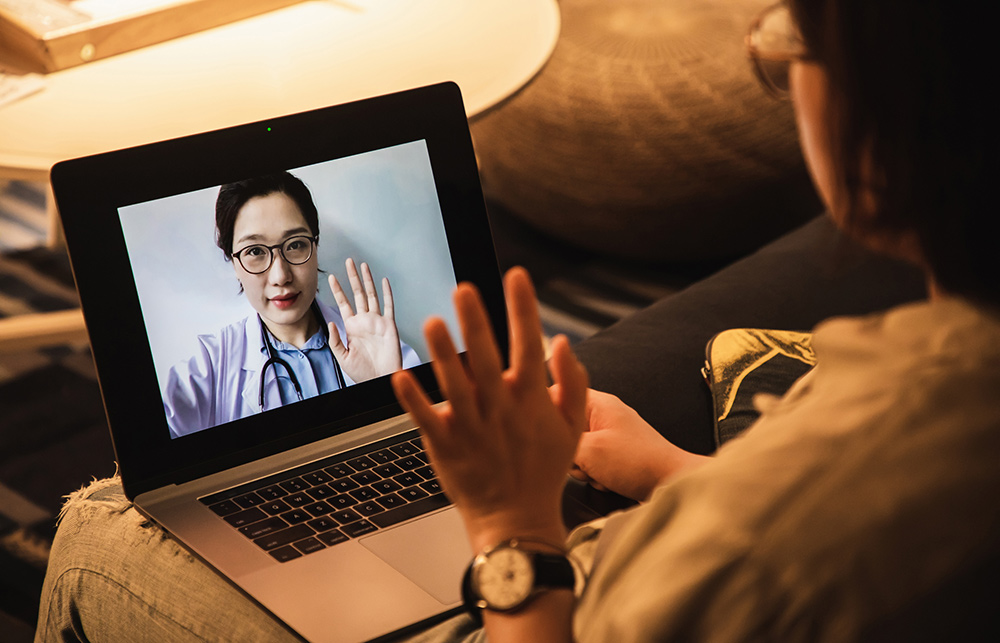
6月3日,,來自多個領(lǐng)域的醫(yī)療專家參加了《財富》健康頭腦風(fēng)暴大會(Brainstorm Health)的啟動電話會議。今年的大會將采取虛擬活動的形式,,于7月7日和8日召開,。
紐約長老會醫(yī)院(New York Presbyterian)院長兼CEO斯蒂文?科溫醫(yī)生,、Verily Life Sciences醫(yī)療平臺總裁維維安?李醫(yī)生、Komodo Health公司CEO兼聯(lián)合創(chuàng)始人阿里夫?納索醫(yī)生等業(yè)內(nèi)精英暢所欲言,,就新冠疫情在美國醫(yī)療體系中產(chǎn)生的連鎖反應(yīng)發(fā)表了各自的見解,。
參會嘉賓達成了什么明確的共識?在疫情期間,,遠程醫(yī)療使用量飆升,,這種趨勢可能會延續(xù)下去。
如此大規(guī)模的疫情,,自然令醫(yī)院容量面臨壓力,心臟病和糖尿病等慢性病患者可能不愿意到醫(yī)院就診,,以免讓自己面臨風(fēng)險,。維維安?李表示,在這種情況下,,遠程醫(yī)療,、虛擬就診和其他數(shù)字醫(yī)療技術(shù)發(fā)揮了關(guān)鍵作用。
她說:“能通過虛擬方式看醫(yī)生是很了不起的,?!钡匾氖牵瑪?shù)字糖尿病護理平臺等技術(shù)的發(fā)展,,“讓人們可以用更好的方式進行自我護理,。”
維維安?李認為,,這些平臺最初發(fā)展緩慢,,部分原因是它們沒有得到應(yīng)得的資金支持。但現(xiàn)在,,聯(lián)邦醫(yī)療保險等大型醫(yī)療計劃都開始將持續(xù)血糖監(jiān)測和數(shù)字糖尿病患者輔導(dǎo)等技術(shù)納入報銷范圍,。這些技術(shù)能夠?qū)崟r通知患者哪些行為會影響血糖水平。
美國部分最知名的醫(yī)療系統(tǒng)對遠程醫(yī)療的需求大幅增加,。比如紐約長老會醫(yī)院院長科溫表示,,在疫情爆發(fā)之前,約4%的門診為遠程醫(yī)療就診,。他說:“疫情期間,,85%的門診為遠程醫(yī)療就診,現(xiàn)在95%的精神病科門診采取遠程醫(yī)療的形式,。醫(yī)生基本上都采取了這種技術(shù),。”
新的數(shù)字醫(yī)療模式也被應(yīng)用到了新冠肺炎的治療當(dāng)中,。例如,,科溫表示,,不需要住院治療的新冠肺炎患者,目前都在家接受遠程監(jiān)控,。
疫情導(dǎo)致的長期變化將讓這種趨勢延續(xù)下去,。“候診室里不會再有30個人在候診,,電梯里也不會站滿15個人,。這些巨大的變化再也不可能回到從前?!?
雖然疫情帶來了機會,,但挑戰(zhàn)依舊存在。例如,,如果本來就缺醫(yī)少藥的偏遠地區(qū)改為采用遠程醫(yī)療,,就必須建設(shè)寬帶基礎(chǔ)設(shè)施,以支持虛擬就診,。
但科溫和多位參會嘉賓都相信數(shù)字醫(yī)療的發(fā)展“已經(jīng)勢不可擋”,。
譯者:Biz
6月3日,來自多個領(lǐng)域的醫(yī)療專家參加了《財富》健康頭腦風(fēng)暴大會(Brainstorm Health)的啟動電話會議,。今年的大會將采取虛擬活動的形式,,于7月7日和8日召開。
紐約長老會醫(yī)院(New York Presbyterian)院長兼CEO斯蒂文?科溫醫(yī)生,、Verily Life Sciences醫(yī)療平臺總裁維維安?李醫(yī)生,、Komodo Health公司CEO兼聯(lián)合創(chuàng)始人阿里夫?納索醫(yī)生等業(yè)內(nèi)精英暢所欲言,就新冠疫情在美國醫(yī)療體系中產(chǎn)生的連鎖反應(yīng)發(fā)表了各自的見解,。
參會嘉賓達成了什么明確的共識,?在疫情期間,遠程醫(yī)療使用量飆升,,這種趨勢可能會延續(xù)下去,。
如此大規(guī)模的疫情,自然令醫(yī)院容量面臨壓力,,心臟病和糖尿病等慢性病患者可能不愿意到醫(yī)院就診,,以免讓自己面臨風(fēng)險。維維安?李表示,,在這種情況下,,遠程醫(yī)療、虛擬就診和其他數(shù)字醫(yī)療技術(shù)發(fā)揮了關(guān)鍵作用,。
她說:“能通過虛擬方式看醫(yī)生是很了不起的,。”但更重要的是,數(shù)字糖尿病護理平臺等技術(shù)的發(fā)展,,“讓人們可以用更好的方式進行自我護理,。”
維維安?李認為,,這些平臺最初發(fā)展緩慢,,部分原因是它們沒有得到應(yīng)得的資金支持。但現(xiàn)在,,聯(lián)邦醫(yī)療保險等大型醫(yī)療計劃都開始將持續(xù)血糖監(jiān)測和數(shù)字糖尿病患者輔導(dǎo)等技術(shù)納入報銷范圍,。這些技術(shù)能夠?qū)崟r通知患者哪些行為會影響血糖水平。
美國部分最知名的醫(yī)療系統(tǒng)對遠程醫(yī)療的需求大幅增加,。比如紐約長老會醫(yī)院院長科溫表示,,在疫情爆發(fā)之前,約4%的門診為遠程醫(yī)療就診,。他說:“疫情期間,,85%的門診為遠程醫(yī)療就診,現(xiàn)在95%的精神病科門診采取遠程醫(yī)療的形式,。醫(yī)生基本上都采取了這種技術(shù)?!?
新的數(shù)字醫(yī)療模式也被應(yīng)用到了新冠肺炎的治療當(dāng)中,。例如,科溫表示,,不需要住院治療的新冠肺炎患者,,目前都在家接受遠程監(jiān)控。
疫情導(dǎo)致的長期變化將讓這種趨勢延續(xù)下去,?!昂蛟\室里不會再有30個人在候診,電梯里也不會站滿15個人,。這些巨大的變化再也不可能回到從前,。”
雖然疫情帶來了機會,,但挑戰(zhàn)依舊存在,。例如,如果本來就缺醫(yī)少藥的偏遠地區(qū)改為采用遠程醫(yī)療,,就必須建設(shè)寬帶基礎(chǔ)設(shè)施,,以支持虛擬就診。
但科溫和多位參會嘉賓都相信數(shù)字醫(yī)療的發(fā)展“已經(jīng)勢不可擋”,。
譯者:Biz
A wide-ranging group of health care experts on last Wednesday joined a kickoff call for Fortune's Brainstorm Health conference in the lead up to our virtual event which will be held on July 7 and 8.
The conversation featured thoughts from prominent leaders including New York Presbyterian president and CEO Dr. Steven Corwin, Verily Life Sciences president of health platforms Dr. Vivian Lee, Komodo Health CEO and co-founder Dr. Arif Nathoo, and others on the ripple effects of the coronavirus pandemic across the American health care system.
One are of clear consensus among the participants? Telehealth use has skyrocketed during the outbreak—and the trend is probably here to stay.
A pandemic of this scope naturally strains hospital capacity, and people with chronic conditions such as heart problems and diabetes likely don't want to go into a hospital setting where they put themselves at risk. That's where telemedicine, virtual doctor visits, and other digital health technologies play a critical role, says Lee.
"It's great that you can see doctor virtually," she says—but even more importantly, advances such as digital diabetes care platforms "have enabled people to care for themselves in even better ways."
Those sorts of platforms were initially slow to take off in large part because they weren't reimbursed to the extent they should have been, according to Lee. Now, however, large health programs such as Medicare have begun to cover technologies such as continuous glucose monitors and digital diabetes coaching which can inform patients in real time about which behaviors affect their blood sugar levels.
Demand for telehealth has surged in some of the nation's most prominent health systems. For instance, before the pandemic began, New York Presbyterian's Corwin says that about 4% of outpatient visits were telehealth visits. "During the crisis, it's 85%, and 95% of our outpatient psychiatry visits are now telemedicine," he notes. "Physicians have now basically crossed the rubicon."
That new digital paradigm extends to COVID-19 as well. For instance, says Corwin, patients who have COVID-19 but aren't sick enough to require hospitalization are now being monitored remotely in their own homes.
Long-term changes wrought by the pandemic will only keep the trend going. "You can’t have 30 people in a waiting room or 15 people in an elevator anymore. This has all changed dramatically and there’s no going back on that."
But despite the opportunity, challenges remain. For instance, should rural communities which already have a shortage of hospitals turn to telemedicine, the broadband infrastructure to support virtual visits must be built.
Ultimately, however, Corwin and multiple other participants believe "the horse is out of the barn" on digital health.






